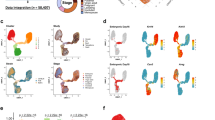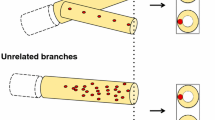Abstract
The eleventh annual workshop of the European Network for Breast Development and Cancer, Methods in mammary gland biology and breast cancer, took place on the 16th to 18th of May 2019 in Weggis, Switzerland. The main topics of the meeting were high resolution genomics and proteomics for the study of mammary gland development and cancer, breast cancer signaling, tumor microenvironment, preclinical models of breast cancer, and tissue morphogenesis. Exciting novel findings in, or highly relevant to, mammary gland biology and breast cancer field were presented, with insights into the methods used to obtain them. Among others, the discussed methods included single-cell RNA sequencing, genetic barcoding, lineage tracing, spatial transcriptomics, optogenetics, genetic mouse models and organoids.

Similar content being viewed by others
Abbreviations
- 53BP1:
-
p53-binding protein 1
- BRCA1:
-
BRCA1 DNA repair associated
- cAMP:
-
cyclic adenosine monophosphate
- CAF:
-
cancer-associated fibroblast
- CDC42EP3:
-
cell division cycle 42 effector protein 3
- CREB1:
-
cAMP responsive element binding protein 1
- EGFR:
-
epithelial growth factor receptor
- ECM:
-
extracellular matrix
- EMBL:
-
European Molecular Biology Laboratory
- ENBDC:
-
European Network of Breast Development and Cancer
- ER:
-
estrogen receptor
- FGF:
-
fibroblast growth factor
- FGFR:
-
fibroblast growth factor receptor
- IDC:
-
invasive ductal carcinoma
- MSPC:
-
mammary stem/progenitor cell
- NOTCH4:
-
notch receptor 4
- PARP:
-
poly (ADP-ribose) polymerase
- PARPi:
-
PARP inhibitor
- PR:
-
progesterone receptor
- RSK2:
-
p90 ribosomal S6 kinase 2
- scRNAseq:
-
single cell RNA sequencing
- TNBC:
-
triple negative breast cancer
- UK:
-
United Kingdom
- VPS11:
-
vacuolar protein sorting-associated protein 11 homolog
- YAP:
-
Yes-associated protein
References
Pal B, Chen Y, Vaillant F, Jamieson P, Gordon L, Rios AC, et al. Construction of developmental lineage relationships in the mouse mammary gland by single-cell RNA profiling. Nat Commun. 2017;8:1627.
Merino D, Weber TS, Serrano A, Vaillant F, Liu K, Pal B, et al. Barcoding reveals complex clonal behavior in patient-derived xenografts of metastatic triple negative breast cancer. Nat Commun. 2019;10:766.
Ståhl PL, Salmén F, Vickovic S, Lundmark A, Navarro JF, Magnusson J, et al. Visualization and analysis of gene expression in tissue sections by spatial transcriptomics. Science. 2016;353:78–82.
Salmén F, Vickovic S, Larsson L, Stenbeck L, Vallon-Christersson J, Ehinger A, et al. Multidimensional transcriptomics provides detailed information about immune cell distribution and identity in HER2+ breast tumors. bioRxiv. 2018;358937.
Francavilla C, Rigbolt KTG, Emdal KB, Carraro G, Vernet E, Bekker-Jensen DB, et al. Functional proteomics defines the molecular switch underlying FGF receptor trafficking and cellular outputs. Mol Cell. 2013;51:707–22.
Piasecka D, Kitowska K, Czaplinska D, Mieczkowski K, Mieszkowska M, Turczyk L, et al. Fibroblast growth factor signalling induces loss of progesterone receptor in breast cancer cells. Oncotarget. 2016;7:86011–25.
Piasecka D, Braun M, Kitowska K, Mieczkowski K, Kordek R, Sadej R, et al. FGFs/FGFRs-dependent signalling in regulation of steroid hormone receptors - implications for therapy of luminal breast cancer. J Exp Clin Cancer Res CR. 2019;38:230.
Berto M, Jean V, Zwart W, Picard D. ERα activity depends on interaction and target site corecruitment with phosphorylated CREB1. Life Sci Alliance. 2018;1:e201800055.
Segala G, Bennesch MA, Ghahhari NM, Pandey DP, Echeverria PC, Karch F, et al. Vps11 and Vps18 of Vps-C membrane traffic complexes are E3 ubiquitin ligases and fine-tune signalling. Nat Commun. 2019;10:1833.
Gaggioli C, Hooper S, Hidalgo-Carcedo C, Grosse R, Marshall JF, Harrington K, et al. Fibroblast-led collective invasion of carcinoma cells with differing roles for RhoGTPases in leading and following cells. Nat Cell Biol. 2007;9:1392–400.
Calvo F, Ege N, Grande-Garcia A, Hooper S, Jenkins RP, Chaudhry SI, et al. Mechanotransduction and YAP-dependent matrix remodelling is required for the generation and maintenance of cancer-associated fibroblasts. Nat Cell Biol. 2013;15:637–46.
Calvo F, Ranftl R, Hooper S, Farrugia AJ, Moeendarbary E, Bruckbauer A, et al. Cdc42EP3/BORG2 and Septin network enables Mechano-transduction and the emergence of Cancer-associated fibroblasts. Cell Rep. 2015;13:2699–714.
Duarte AA, Gogola E, Sachs N, Barazas M, Annunziato S, R de Ruiter J, et al. BRCA-deficient mouse mammary tumor organoids to study cancer-drug resistance. Nat Methods. 2018;15:134–40.
Gogola E, Duarte AA, de Ruiter JR, Wiegant WW, Schmid JA, de Bruijn R, et al. Selective loss of PARG restores PARylation and counteracts PARP inhibitor-mediated synthetic lethality. Cancer Cell. 2018;33:1078–93 e12.
Noordermeer SM, Adam S, Setiaputra D, Barazas M, Pettitt SJ, Ling AK, et al. The shieldin complex mediates 53BP1-dependent DNA repair. Nature. 2018;560:117–21.
Barazas M, Gasparini A, Huang Y, Küçükosmanoğlu A, Annunziato S, Bouwman P, et al. Radiosensitivity is an acquired vulnerability of PARPi-resistant BRCA1-deficient tumors. Cancer Res. 2019;79:452–60.
Acerbi I, Cassereau L, Dean I, Shi Q, Au A, Park C, et al. Human breast cancer invasion and aggression correlates with ECM stiffening and immune cell infiltration. Integr Biol Quant Biosci Nano Macro. 2015;7:1120–34.
Mohammadi H, Sahai E. Mechanisms and impact of altered tumour mechanics. Nat Cell Biol. 2018;20:766–74.
Mayorca-Guiliani AE, Madsen CD, Cox TR, Horton ER, Venning FA, Erler JT. ISDoT: in situ decellularization of tissues for high-resolution imaging and proteomic analysis of native extracellular matrix. Nat Med. 2017;23:890–8.
Northcott JM, Dean IS, Mouw JK, Weaver VM. Feeling stress: the mechanics of Cancer progression and aggression. Front Cell Dev Biol. 2018;6:17.
Simões BM, O’Brien CS, Eyre R, Silva A, Yu L, Sarmiento-Castro A, et al. Anti-estrogen resistance in human breast tumors is driven by JAG1-NOTCH4-dependent Cancer stem cell activity. Cell Rep. 2015;12:1968–77.
Zhao Y, Hu Q, Cheng F, Su N, Wang A, Zou Y, et al. SoNar, a highly responsive NAD+/NADH sensor, allows high-throughput metabolic screening of anti-tumor agents. Cell Metab. 2015;21:777–89.
Nelson CM. On Buckling Morphogenesis. J Biomech Eng. 2016;138:021005.
Pearl EJ, Li J, Green JBA. Cellular systems for epithelial invagination. Philos Trans R Soc B Biol Sci. 2017;372:20150526.
Li J, Economou AD, Green JBA. Epithelial invagination by vertical telescoping. bioRxiv. 2019;515981.
Izquierdo E, Quinkler T, De Renzis S. Guided morphogenesis through optogenetic activation of rho signalling during early Drosophila embryogenesis. Nat Commun. 2018;9:2366.
Krueger D, Tardivo P, Nguyen C, De Renzis S. Downregulation of basal myosin-II is required for cell shape changes and tissue invagination. EMBO J. 2018;37.
Wuidart A, Ousset M, Rulands S, Simons BD, Van Keymeulen A, Blanpain C. Quantitative lineage tracing strategies to resolve multipotency in tissue-specific stem cells. Genes Dev. 2016;30:1261–77.
Wuidart A, Sifrim A, Fioramonti M, Matsumura S, Brisebarre A, Brown D, et al. Early lineage segregation of multipotent embryonic mammary gland progenitors. Nat Cell Biol. 2018;20:666–76.
Santoro A, Vlachou T, Carminati M, Pelicci PG, Mapelli M. Molecular mechanisms of asymmetric divisions in mammary stem cells. EMBO Rep. 2016;17:1700–20.
Myllymäki S-M, Mikkola ML. Inductive signals in branching morphogenesis - lessons from mammary and salivary glands. Curr Opin Cell Biol. 2019;61:72–8.
Lloyd-Lewis B, Mourikis P, Fre S. Notch signalling: sensor and instructor of the microenvironment to coordinate cell fate and organ morphogenesis. Curr Opin Cell Biol. 2019;61:16–23.
Koledova Z, Sumbal J. A pleiotropic role for FGF signaling in mammary gland stromal fibroblasts. bioRxiv. 2019;565267.
Lerche M, Elosegui-Artola A, Guzmán C, Georgiadou M, Kechagia JZ, Gullberg D, et al. Integrin binding dynamics modulate ligand-specific mechanosensing in mammary gland fibroblasts. bioRxiv. 2019;570721.
Marusiak AA, Prelowska MK, Mehlich D, Lazniewski M, Kaminska K, Gorczynski A, et al. Upregulation of MLK4 promotes migratory and invasive potential of breast cancer cells. Oncogene. 2019;38:2860–75.
Koledova Z, Howard BA, Englund J, Bach K, Bentires-Alj M, Gonzalez-Suarez E. European network of breast development and Cancer turned 10 years: a growing family of mammary gland researchers. Breast Cancer Res BCR. 2018;20:102.
Acknowledgements
The authors thank Xiomara Banholzer for help with the organization of the meeting.
Funding
Funding for the meeting was received from Krebsforschung Schweiz and Krebsliga Schweiz, Novartis, The Company of Biologists, Frontiers in Cell and Developmental Biology, Cytoskeleton Inc., and from European Association for Cancer Research. VV has been supported by the Swiss National Science Foundation, EP has been supported by Academy of Finland and Finnish Cultural foundation. MLM received funding from Academy of Finland, Cancer Foundation Finland, and Sigrid Juselius Foundation. Research in the MB-A laboratory is supported by the Swiss Initiative for Systems Biology- SystemsX, the European Research Council (grant no. 694033 STEM-BCPC), the Swiss National Science Foundation, Novartis, the Krebsliga Beider Basel, the Swiss Cancer League, the Swiss Personalized Health Network (Swiss Personalized Oncology driver project) and the Department of Surgery of the University Hospital Basel. ZK is supported by the Grant Agency of Masaryk University (grants no. MUNI/G/1446/2018 and MUNI/E/0519/2019).
Author information
Authors and Affiliations
Contributions
VV, EP, MLM, WTK, MB-A, and ZK wrote the manuscript. All authors approved the final manuscript.
Corresponding author
Ethics declarations
Ethics Approval and Consent to Participate
Not applicable.
Consent for Publication
The manuscript has been read and approved by all authors, has not been published previously in print or electronic format, and is not under consideration by another publication or electronic medium. Consent for publication has been obtained from all the speakers.
Conflict of Interest
The authors declare that they have no conflict of interest.
Additional information
Publisher’s Note
Springer Nature remains neutral with regard to jurisdictional claims in published maps and institutional affiliations.
Rights and permissions
About this article
Cite this article
Vafaizadeh, V., Peuhu, E., Mikkola, M.L. et al. The Eleventh ENBDC Workshop: Advances in Technology Help to Unveil Mechanisms of Mammary Gland Development and Cancerogenesis. J Mammary Gland Biol Neoplasia 24, 201–206 (2019). https://doi.org/10.1007/s10911-019-09436-0
Received:
Accepted:
Published:
Issue Date:
DOI: https://doi.org/10.1007/s10911-019-09436-0




